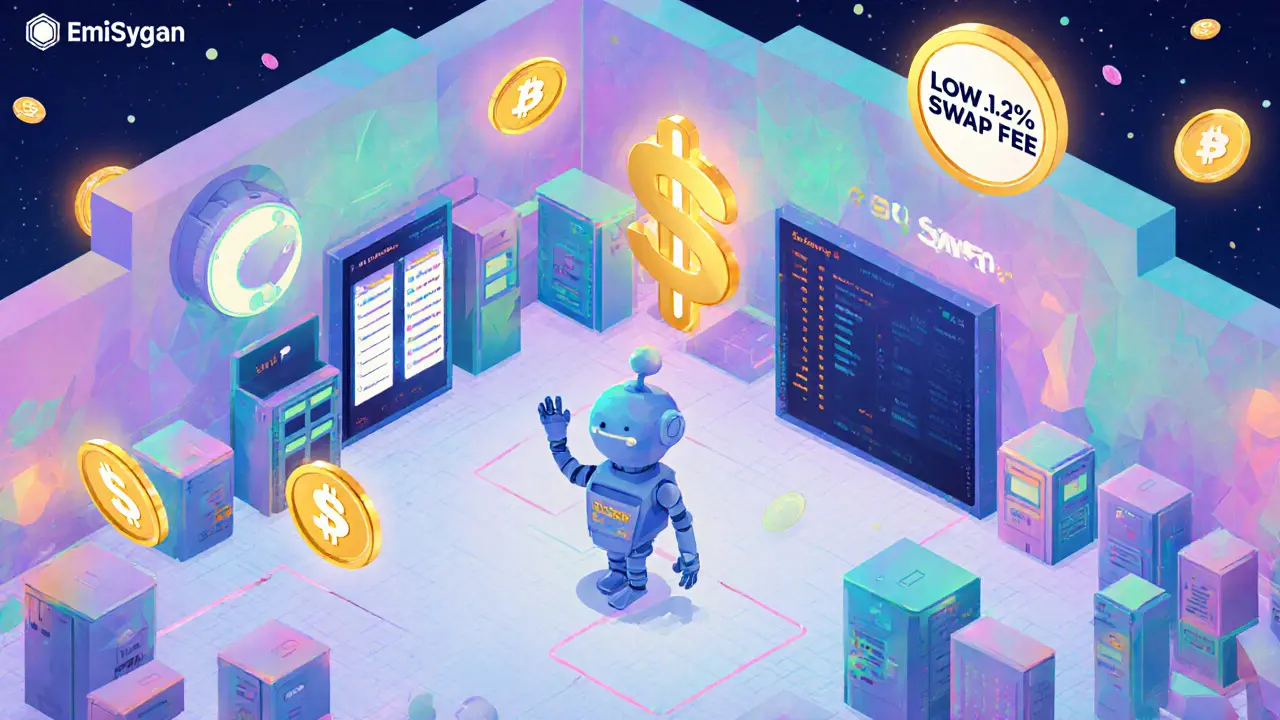EmiSwap Yield Calculator
Liquidity Provider Calculator
Estimated Rewards
Daily Earnings
$0.00
30-Day Earnings
$0.00
Based on current rates. Note: APRs are extremely high and potentially unsustainable.
Important Risk Warning
High APRs like these (up to 1000% farming + 365% airdrop) are typically unsustainable. These rewards are often derived from token emissions rather than actual revenue, making them highly volatile and subject to collapse. Only risk capital you can afford to lose.
When you hear the name EmiSwap is a cross‑chain automated market maker (AMM) decentralized exchange that targets higher rewards for liquidity providers, you’re looking at a platform that runs on the Polygon network and ties its tokenomics to the native $ESW token. This EmiSwap crypto exchange promises aggressive yield farming, a 365% APR airdrop, and a community‑governed model that claims to be the first to blend NFT mechanics with DEX governance.
How EmiSwap Works: The Core Mechanics
At its heart, EmiSwap follows the standard AMM model you see on most decentralized exchanges. Users connect a compatible wallet - most commonly MetaMask (or Fortmatic for mobile‑first users) - and then deposit assets into a liquidity pool. In return, the protocol issues LP (liquidity provider) tokens that represent your share of the pool.
Those LP tokens don’t sit idle. EmiSwap adds a dedicated "Farming" tab where you can stake LP tokens to earn daily $ESW distributions. The platform’s reward schedule is layered:
- Standard fee share: 0.2% of every swap in a pool is allocated to LPs.
- Yield farming: Certain pools offer up to 1000% APR, paid in $ESW.
- Airdrop program: Polygon‑based liquidity providers receive a 365% APR airdrop, calculated as a 1% daily return plus additional staking rewards.
Because the airdrop hinges on maintaining your liquidity position until the first distribution, users must keep their funds in the pool for at least a few days to stay eligible.
Reward Structure Compared to Major DEXes
High APRs sound enticing, but they must be viewed against the backdrop of liquidity depth, token utility, and sustainability. Below is a quick snapshot of how EmiSwap stacks up against three well‑known DEXes.
| Platform | Base Swap Fee | Typical APR for Farming | Primary Network |
|---|---|---|---|
| EmiSwap | 0.2% | Up to 1000% (special pools) + 365% airdrop on Polygon | Polygon |
| Uniswap | 0.3% | Typically 10‑30% on V3 liquidity incentives | Ethereum (L2 options) |
| PancakeSwap | 0.25% | 30‑200% depending on farm | Binance Smart Chain |
| SushiSwap | 0.25% | 15‑150% on Kashi lending farms | Multiple (Ethereum, BSC, Polygon) |
The fee advantage (0.2% vs. 0.3% on Uniswap) is modest, but the headline APRs are dramatically higher. Those numbers often come from early‑stage token emissions meant to bootstrap liquidity rather than long‑term sustainable yields.

Security, Audits & Regulatory Context
EmiSwap claims to have undergone a security audit, though the publicly available documentation does not name the audit firm or list the audit date. In the DeFi world, that opacity raises a red flag; reputable projects usually publish a full audit report from firms like CertiK, PeckShield, or Quantstamp.
The platform’s parent team also runs Emirex is a regulated centralized exchange based in Estonia, holding license FVT000400 for virtual currency wallet services and fiat‑to‑crypto exchange. While Emirex’s licensing adds a layer of credibility, it does not directly translate to the security of the decentralized protocol, which operates without KYC and without a central authority that could intervene in an emergency.
For risk‑averse users, the lack of a detailed audit, combined with the aggressive reward rates, suggests you should treat EmiSwap as a high‑risk, high‑potential‑reward experiment. Keep any exposure small until the platform matures and independent audits become public.
Step‑By‑Step: Adding Liquidity and Farming on EmiSwap
- Install a compatible wallet such as MetaMask and switch the network to Polygon.
- Navigate to the EmiSwap website and click “Connect Wallet”. Approve the connection in your wallet UI.
- Go to the “Add Liquidity” tab. Choose a pair (e.g., USDC/ETH), enter the amount you wish to supply, and confirm the transaction. The protocol will mint LP tokens automatically.
- Open the “Farming” tab. Locate the pool that matches your LP token and click “Stake”. Confirm the staking transaction - this locks your LP tokens in the farm.
- Monitor your dashboard for daily $ESW rewards. You can claim them manually or set up an auto‑claim script if you’re comfortable with basic scripting.
- If you’re part of the 365% APR airdrop, ensure your liquidity stays in the pool at least until the first airdrop distribution (usually within a week of staking).
- When you decide to exit, unstake your LP tokens, remove liquidity, and withdraw the underlying assets back to your wallet.
Each transaction incurs a small Polygon gas fee (often less than $0.01), making the overall cost structure lean compared to Ethereum‑only DEXes.

Governance, NFTs & Community Direction
EmiSwap markets itself as the “first community‑governed DEX with NFT mechanics”. In practice, $ESW holders can propose and vote on protocol upgrades, fee adjustments, and new pool listings. The exact voting power calculation isn’t publicly detailed, but it appears to be proportional to staked $ESW.
On the NFT side, the platform plans to issue “Liquidity NFTs” that represent a staked position. Owners could later trade or use these NFTs in other DeFi applications, effectively tokenizing the LP stake. As of now, no such NFTs are live, making this more of a roadmap promise than a functional feature.
The community that drives these decisions is primarily hosted on a Telegram channel and a Discord server. Since user sentiment data is scarce, it’s hard to gauge how active or influential the community truly is.
Pros, Cons & Bottom Line
Pros
- Low base swap fee (0.2%) compared to many competitors.
- Aggressive APRs (up to 1000% farming, 365% airdrop) can attract early liquidity.
- Runs on Polygon, offering cheap and fast transactions.
- Backed by a regulated CEX (Emirex), which may help future compliance work.
Cons
- Lack of publicly available audit reports creates uncertainty.
- Reward rates appear unsustainable for long‑term operation.
- Limited cross‑chain support details; currently only Polygon is clearly documented.
- Scarce user reviews and community data make risk assessment difficult.
For seasoned DeFi hunters who enjoy high‑risk yield farming and are comfortable with limited oversight, EmiSwap can be a fun playground. If you prefer proven stability, established DEXes like Uniswap or SushiSwap still dominate in liquidity depth and audit transparency.
Frequently Asked Questions
What is the $ESW token used for?
$ESW is the native reward token on EmiSwap. It is distributed to liquidity providers as a share of swap fees, farming yields, and the 365% airdrop. Holders can also stake $ESW for governance voting and potentially earn additional staking rewards.
Do I need to complete KYC to use EmiSwap?
No. EmiSwap is a decentralized protocol, so you only need a compatible wallet. The platform does not collect personal data or require identity verification.
Is EmiSwap audited?
The project states that it has undergone a security audit, but the audit report, auditor name, and date are not publicly available. Until an independent audit is published, treat the platform as unaudited.
Can I trade assets other than Polygon tokens?
Currently EmiSwap only lists pools on the Polygon network. The roadmap mentions cross‑chain expansion, but no other blockchains are officially supported yet.
How do I claim my $ESW rewards?
After staking LP tokens, navigate to the Farming dashboard, click “Claim” next to the relevant pool, and confirm the transaction in your wallet. Rewards are distributed daily, so you can claim as often as you like.
What risks should I watch for?
Key risks include smart‑contract bugs (no public audit), impermanent loss from volatile asset pairs, and the possibility that high APRs are unsustainable, leading to token price drops. Only allocate capital you can afford to lose.



Comments
You ever notice how every new crypto platform pops up right after a big dip? Feels like they're timed to the exact moment you’re scrounging for a comeback, like some hidden hand is pulling the strings. And EmiSwap? Their reward numbers look almost too good to be true, like a miracle on a billboard. I swear there’s a secret algorithm that decides who gets the juicy airdrops. Probably backed by some shadowy group that never wants you to figure it out. Just saying, keep your eyes peeled and your wallet safe.
When assessing platforms like EmiSwap, it’s essential to weigh the advertised yields against the underlying tokenomics. The high APRs often stem from token emissions rather than sustainable revenue streams, which introduces considerable volatility. Users should allocate only capital they can afford to lose, given the potential for rapid de‑valuation. Diversifying across established DeFi protocols can also mitigate exposure to such high‑risk offerings.
Alright, let’s break this down step by step so even a newcomer can follow. First, EmiSwap’s headline APRs look dazzling, but they’re primarily driven by fresh token emissions, not real profit. That means the “earnings” are essentially a redistribution of newly minted tokens, which dilutes value over time. Second, the liquidity pool rewards are paid in the platform’s native token, whose price is highly speculative and often correlated with hype cycles. Third, the 365% airdrop claim is a one‑off incentive meant to attract early liquidity, not a sustainable yield source. Fourth, you should consider the impermanent loss you incur when providing assets to a volatile pool – it can easily erase the nominal gains from rewards. Fifth, the smart‑contract risk is non‑trivial; any bug could lock or burn your funds without recourse. Sixth, regulatory uncertainty looms over many DeFi projects, and a sudden crackdown could freeze or shut down services. Seventh, the platform’s fee structure includes a standard 0.3% swap fee, which is typical but still eats into net returns. Eighth, the user interface is fairly intuitive, but the lack of comprehensive documentation can make troubleshooting difficult for beginners. Ninth, security audits have been performed, yet even audited contracts have been compromised in the past. Tenth, community sentiment on social media is mixed – some praise the high yields, others warn of pump‑and‑dump schemes. Eleventh, you’ll need a wallet that supports the network EmiSwap operates on, and you must be comfortable managing private keys. Twelfth, if you’re planning to stake tokens for the airdrop, be aware of the lock‑up period and any withdrawal penalties. Thirteenth, the token’s market depth is relatively shallow, so large trades can cause slippage. Fourteenth, while the platform offers a “Full Earnings” view, it aggregates disparate reward streams that behave differently under market stress. Fifteenth, in terms of governance, token holders have limited voting power, which may affect future protocol changes. Sixteenth, always remember the golden rule: never invest more than you can afford to lose. Seventeenth, if you’re drawn by the high percentages, consider testing the waters with a small amount first to gauge the real‑world performance. Eighteenth, keep an eye on the token’s circulating supply; rapid inflation can erode value quickly. Nineteenth, finally, stay updated with the project’s announcements – their roadmap can shift, affecting returns dramatically. In sum, EmiSwap offers tantalizing rewards, but they come with a host of risks that demand diligent research and cautious capital allocation.
Even if the numbers sparkle, the underlying volatility makes the whole thing feel like a roller‑coaster you didn’t sign up for.
The risk warning is pretty clear – you’re basically gambling with high‑yield promises that could evaporate overnight.
Sounds exciting! 🚀 Just remember to keep a safety net, folks. 😎
It is morally indefensible to lure unsuspecting investors with such extravagant promises without transparent disclosure of the inherent hazards. The platform appears to exploit the naivety of newcomers, offering mirage‑like returns that are fundamentally unsound. One must question the ethical foundations of a service that thrives on speculative fervor rather than genuine value creation. This conduct borders on predatory, and it is imperative that regulators intervene before more capital is squandered.
From a practical standpoint, the calculator gives a nice snapshot, but I’d still advise running a few test deposits first. It’s the best way to see how the numbers translate in real‑time, especially when dealing with volatile token prices.
Yo, EmiSwap’s hype train is rolling full steam, but the tracks are made of glass. You’re looking at a reward structure that’s basically a cascade of fresh tokens – impressive on paper, but the moment the influx stops, you’re left with a token that’s got no real utility. Those absurd APRs are like a fireworks display – bright and loud, but it all blows up in a second. If you’re not prepared for the crash after the pump, you’ll end up with a bag of dust. Just keep your expectations in check, and don’t let the shiny numbers blind you.
Wow, another “too good to be true” platform. 🙄 Like we haven’t seen this circus before.
Nice calculator, but I’d still stay skeptical.
Honestly, these reward schemes feel like modern day alchemy – promising gold but ending up with lead. The allure of massive APYs is a siren song that lures the unwary into shallow waters. When the token emissions dry up, you’re left holding a depreciating asset that’s barely worth the transaction fees you paid. It’s a classic case of hype over substance, dressed up in slick UI and flashy graphics. Bottom line: keep your wits about you and don’t get dazzled by the numbers alone.
For anyone considering EmiSwap, it’s wise to start small and monitor the actual payouts versus the projected figures. A cautious approach helps you gauge the platform’s reliability without exposing a large portion of your capital.
Hey folks! If you’re eyeing the EmiSwap rewards, remember that excitement can cloud judgement. Take a deep breath, review the tokenomics, and only allocate what you’re comfortable losing. It’s better to be safe than to watch your gains evaporate in a flash.
From a cultural perspective, the DeFi space thrives on innovative experiments, but not every experiment is a success. EmiSwap’s high‑yield model is ambitious, yet it sits on a fragile foundation that could crumble under market pressure. Balance the enthusiasm with a healthy dose of skepticism.
It’s fascinating to see how platforms like EmiSwap try to attract liquidity with massive airdrops, but the sustainability question remains. If you decide to dive in, consider setting clear exit strategies.
Sounds risky, but could be fun for a tiny test.
EmiSwap’s calculator is a handy tool, yet it’s crucial to remember that projected rewards are based on current rates which can shift dramatically. Use it as a guide, not a guarantee.
Such overblown promises only attract the gullible; true value lies elsewhere.
Consider the philosophical angle: chasing exorbitant yields often leads to a never‑ending cycle of desire and disappointment. A measured approach aligns better with long‑term financial well‑being.
From a technical standpoint, the smart contracts appear clean, but any oversight could be catastrophic. Continuous monitoring and independent audits are essential before committing substantial funds.
High APRs look tempting, yet they’re often a mask for inflationary tokenomics. Dive deep into the supply schedule before you jump in.
Honestly, these platforms are just another hype bubble waiting to burst.
Stay positive, but stay protected. A small allocation can give you a feel for the system without jeopardizing your core portfolio.
Philosophically, the quest for outsized returns reflects a deeper human desire for quick success, yet prudence remains the wiser path.